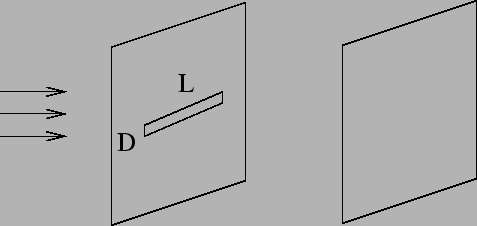 |
Consider a situation where light from a distant source falls on a
rectangular slit of width ![]() and length
and length ![]() as shown in Figure
12.3. We shall assume that
as shown in Figure
12.3. We shall assume that ![]() is much larger than
is much larger than
![]() . We are interested in the image on a screen which is at a
great distance from the slit.
. We are interested in the image on a screen which is at a
great distance from the slit.
As the source is very far away, we can treat the incident light as plane wave. Further the source is aligned so that the incident wavefronts are parallel to the plane of the slit. Every point in the slit emits a spherical secondary wavelet.These secondary wavelets are well described by plane waves by the time they reach the distant screen. This situation where the incident wave and the emergent secondary waves can all be treated as plane waves is referred to as Fraunhofer diffraction. In this case both, the source as well as the screen are effectively at infinity from the obstacle.
We assume L to be very large so that the problem can be treated as
one dimensional as shown in Figure 12.4. Instead of
placing the screen far away, it is equivalent to introduce a lens
and place the screen at the focal plane. Each point on the slit
acts like a secondary source. These secondary sources are all in
phase and they all emit secondary wavelets with the same phase.
Let us calculate the total radiation at a point at an angle
![]() . If
. If
| (12.1) |
| (12.2) |
| (12.3) |
The total electric field can be calculated by adding up the
contribution from all points on the slit. This is an integral
| (12.5) |
 |
(12.6) |
Figure 12.5 shows the intensity as a function of
| (12.8) |
Let us compare the intensity pattern ![]() shown in
Figure 12.5 with the predictions of geometrical
optics. Figure 12.4 shows a beam of parallel rays
incident on a slit of dimension
shown in
Figure 12.5 with the predictions of geometrical
optics. Figure 12.4 shows a beam of parallel rays
incident on a slit of dimension ![]() . In geometrical optics the
only effect of the slit is to cut off some of the rays in the
incident beam and reduce the transverse extent of the beam. We
expect a beam of parallel rays with transverse dimension
. In geometrical optics the
only effect of the slit is to cut off some of the rays in the
incident beam and reduce the transverse extent of the beam. We
expect a beam of parallel rays with transverse dimension ![]() to
emerge from the slit. This beam is now incident on a lens which
will focuses all the rays to a single point on the screen. Thus in
geometrical optics the image is a single bright point on the
screen. In reality the wave nature of light manifests itself
through the phenomena of diffraction, and we see a pattern of
bright spots as shown in Figure 12.5. The central
spot is the brightest and it has an angular extent
The other spots located above and below the central
spot are fainter.
Taking into account both dimensions of the slit we have
to
emerge from the slit. This beam is now incident on a lens which
will focuses all the rays to a single point on the screen. Thus in
geometrical optics the image is a single bright point on the
screen. In reality the wave nature of light manifests itself
through the phenomena of diffraction, and we see a pattern of
bright spots as shown in Figure 12.5. The central
spot is the brightest and it has an angular extent
The other spots located above and below the central
spot are fainter.
Taking into account both dimensions of the slit we have
| (12.9) |
| (12.10) |